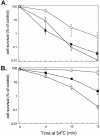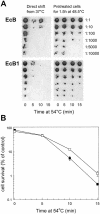The Escherichia coli heat shock protein ClpB restores acquired thermotolerance to a cyanobacterial clpB deletion mutant
- PMID: 11005383
- PMCID: PMC312891
- DOI: 10.1379/1466-1268(2000)005<0255:techsp>2.0.co;2
The Escherichia coli heat shock protein ClpB restores acquired thermotolerance to a cyanobacterial clpB deletion mutant
Abstract
In both prokaryotes and eukaryotes, the heat shock protein ClpB functions as a molecular chaperone and plays a key role in resisting high temperature stress. ClpB is important for the development of thermotolerance in yeast and cyanobacteria but apparently not in Escherichia coli. We undertook a complementation study to investigate whether the ClpB protein from E coli (EcClpB) differs functionally from its cyanobacterial counterpart in the unicellular cyanobacterium Synechococcus sp. PCC 7942. The EcClpB protein is 56% identical to its ClpB1 homologue in Synechococcus. A plasmid construct was prepared containing the entire E coli clpB gene under the control of the Synechococcus clpB1 promoter. This construct was transformed into a Synechococcus clpB1 deletion strain (deltaclpB1) and integrated into a phenotypically neutral site of the chromosome. The full-length EcClpB protein (EcClpB-93) was induced in the transformed Synechococcus strain during heat shock as well as the smaller protein (EcClpB-79) that arises from a second translational start inside the single clpB message. Using cell survival measurements we show that the EcClpB protein can complement the Synechococcus deltaclpB1 mutant and restore its ability to develop thermotolerance. We also demonstrate that both EcClpB-93 and -79 appear to contribute to the degree of acquired thermotolerance restored to the Synechococcus complementation strains.
Figures





Similar articles
-
The truncated form of the bacterial heat shock protein ClpB/HSP100 contributes to development of thermotolerance in the cyanobacterium Synechococcus sp. strain PCC 7942.J Bacteriol. 2000 Dec;182(24):7092-6. doi: 10.1128/JB.182.24.7092-7096.2000. J Bacteriol. 2000. PMID: 11092876 Free PMC article.
-
The heat shock protein ClpB mediates the development of thermotolerance in the cyanobacterium Synechococcus sp. strain PCC 7942.J Bacteriol. 1996 Aug;178(16):4839-46. doi: 10.1128/jb.178.16.4839-4846.1996. J Bacteriol. 1996. PMID: 8759846 Free PMC article.
-
Induction of the heat shock protein ClpB affects cold acclimation in the cyanobacterium Synechococcus sp. strain PCC 7942.J Bacteriol. 1997 Aug;179(16):5111-7. doi: 10.1128/jb.179.16.5111-5117.1997. J Bacteriol. 1997. PMID: 9260953 Free PMC article.
-
ClpB/Hsp100 proteins and heat stress tolerance in plants.Crit Rev Biotechnol. 2016 Oct;36(5):862-74. doi: 10.3109/07388551.2015.1051942. Epub 2015 Jun 30. Crit Rev Biotechnol. 2016. PMID: 26121931 Review.
-
Cyanobacterial heat-shock response: role and regulation of molecular chaperones.Microbiology (Reading). 2014 Apr;160(Pt 4):647-658. doi: 10.1099/mic.0.073478-0. Epub 2014 Feb 3. Microbiology (Reading). 2014. PMID: 24493248 Review.
Cited by
-
Plant Hsp100/ClpB-like proteins: poorly-analyzed cousins of yeast ClpB machine.Plant Mol Biol. 2010 Nov;74(4-5):395-404. doi: 10.1007/s11103-010-9682-8. Epub 2010 Sep 2. Plant Mol Biol. 2010. PMID: 20811767
-
HSP expression depends on its molecular construction and different organs of the chicken: a meta-analysis.Sci Rep. 2022 Sep 1;12(1):14901. doi: 10.1038/s41598-022-18985-0. Sci Rep. 2022. PMID: 36050408 Free PMC article.
-
The truncated form of the bacterial heat shock protein ClpB/HSP100 contributes to development of thermotolerance in the cyanobacterium Synechococcus sp. strain PCC 7942.J Bacteriol. 2000 Dec;182(24):7092-6. doi: 10.1128/JB.182.24.7092-7096.2000. J Bacteriol. 2000. PMID: 11092876 Free PMC article.
-
Novel form of ClpB/HSP100 protein in the cyanobacterium Synechococcus.J Bacteriol. 2001 Dec;183(24):7392-6. doi: 10.1128/JB.183.24.7392-7396.2001. J Bacteriol. 2001. PMID: 11717299 Free PMC article.
-
The Symbiotic Performance of Chickpea Rhizobia Can Be Improved by Additional Copies of the clpB Chaperone Gene.PLoS One. 2016 Feb 4;11(2):e0148221. doi: 10.1371/journal.pone.0148221. eCollection 2016. PLoS One. 2016. PMID: 26845770 Free PMC article.
References
-
- Bustos SA, Golden SS. Light-regulated expression of the psbD gene family in Synechococcus sp. PCC 7942: evidence for the role of duplicated psbD genes in cyanobacteria. Mol Gen Genet. 1992;232:221–230. - PubMed
Publication types
MeSH terms
Substances
LinkOut - more resources
Full Text Sources
Other Literature Sources
